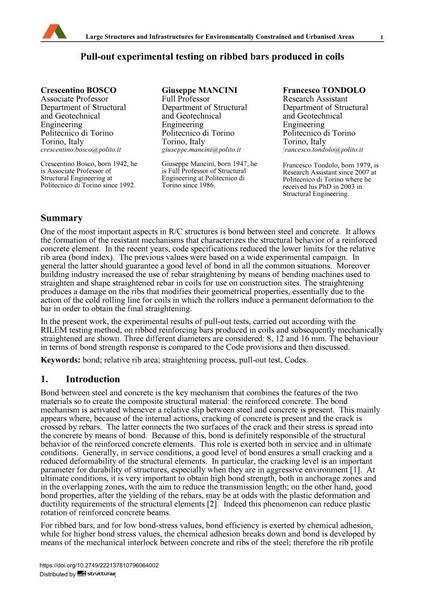Pull-out experimental testing on ribbed bars produced in coils

|
|
|||||||||||
Bibliographic Details
| Author(s): |
Crescentino Bosco
Giuseppe Mancini Francesco Tondolo |
||||
|---|---|---|---|---|---|
| Medium: | conference paper | ||||
| Language(s): | English | ||||
| Conference: | IABSE Symposium: Large Structures and Infrastructures for Environmentally Constrained and Urbanised Areas, Venice, Italy, 22-24 September 2010 | ||||
| Published in: | IABSE Symposium Venice 2010 | ||||
|
|||||
| Page(s): | 842-843 | ||||
| Total no. of pages: | 6 | ||||
| Year: | 2010 | ||||
| DOI: | 10.2749/222137810796064002 | ||||
| Abstract: |
One of the most important aspects in R/C structures is bond between steel and concrete. It allows the formation of the resistant mechanisms that characterizes the structural behavior of a reinforced concrete element. In the recent years, code specifications reduced the lower limits for the relative rib area (bond index). The previous values were based on a wide experimental campaign. In general the latter should guarantee a good level of bond in all the common situations. Moreover building industry increased the use of rebar straightening by means of bending machines used to straighten and shape straightened rebar in coils for use on construction sites. The straightening produces a damage on the ribs that modifies their geometrical properties, essentially due to the action of the cold rolling line for coils in which the rollers induce a permanent deformation to the bar in order to obtain the final straightening. In the present work, the experimental results of pull-out tests, carried out according with the RILEM testing method, on ribbed reinforcing bars produced in coils and subsequently mechanically straightened are shown. Three different diameters are considered: 8, 12 and 16 mm. The behaviour in terms of bond strength response is compared to the Code provisions and then discussed. |
||||
| Keywords: |
bond codes pull-out test relative rib area straightening process
|
||||
